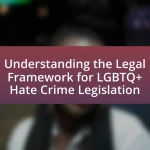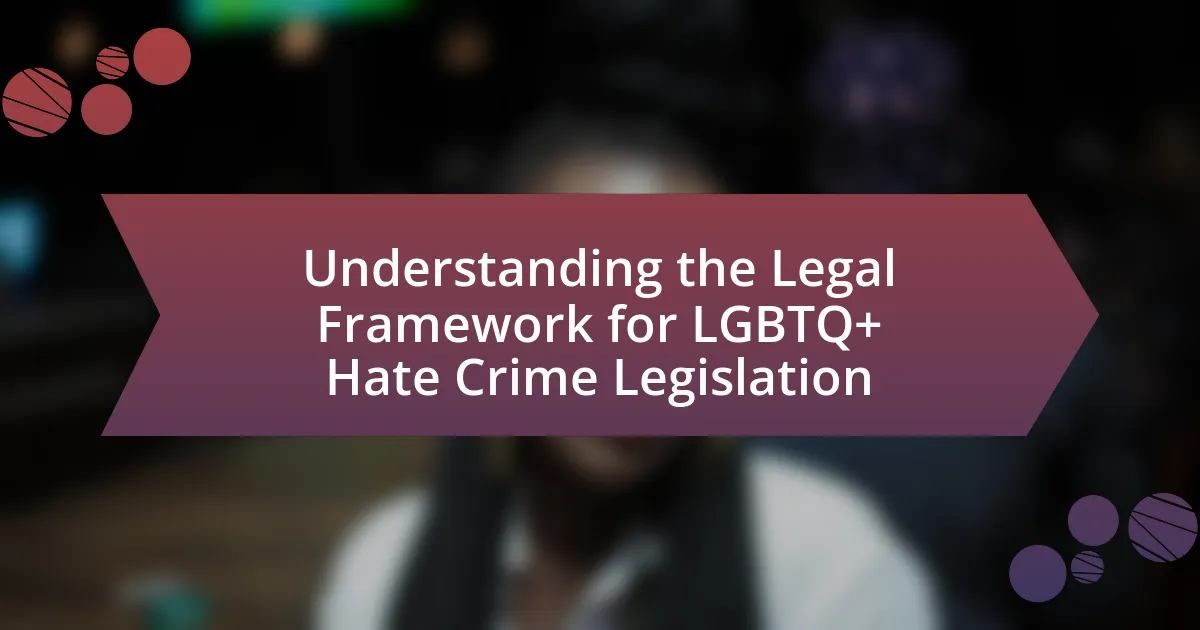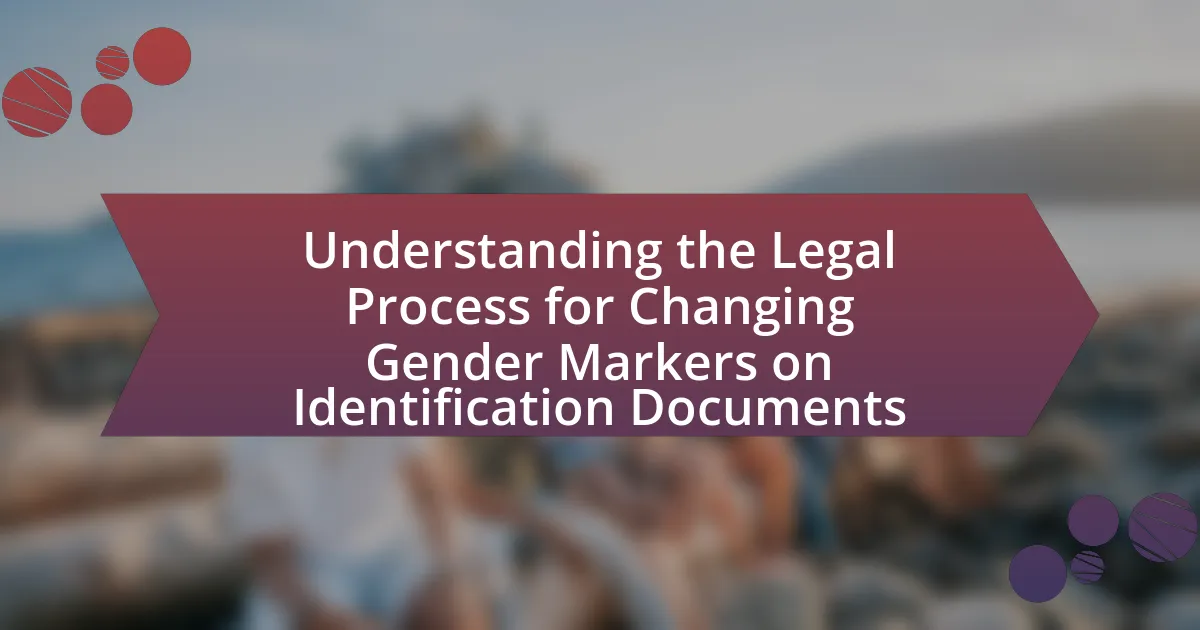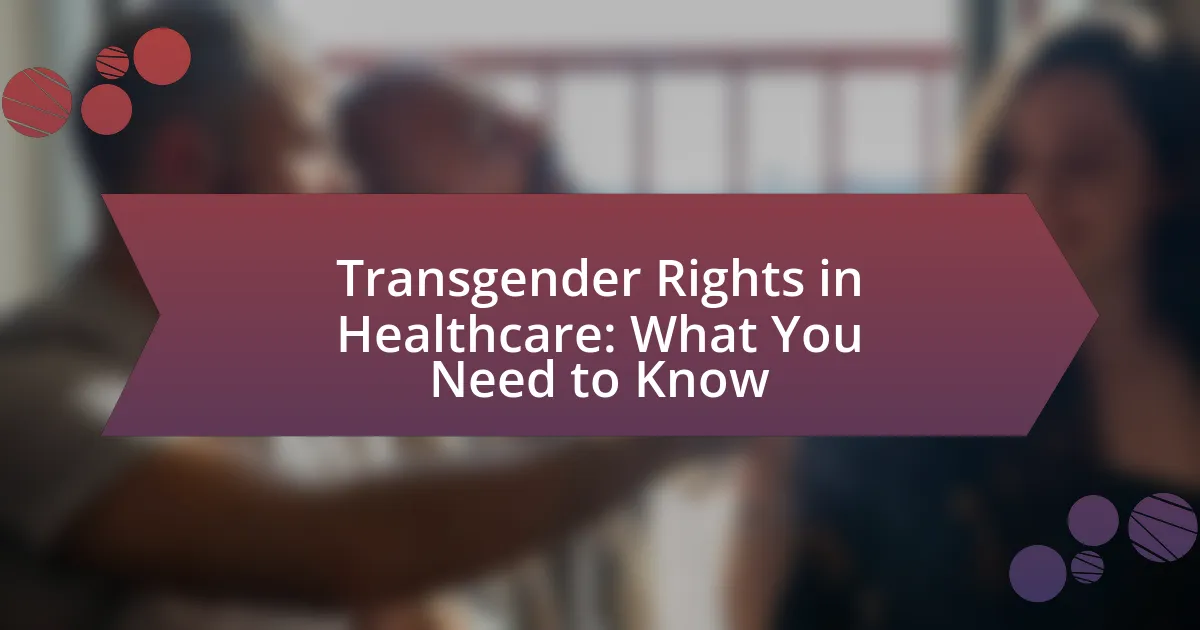The article focuses on the legal protections for LGBTQ+ youth in schools, highlighting various federal and state laws that prohibit discrimination based on sexual orientation and gender identity. It discusses the significance of Title IX and the Equal Protection Clause in safeguarding LGBTQ+ students, as well as the disparities in protections across different states. The article also examines the importance of these legal frameworks in promoting student well-being, the challenges LGBTQ+ youth face despite existing protections, and the role of schools, parents, and advocacy organizations in fostering inclusive environments. Additionally, it outlines best practices for schools to effectively support LGBTQ+ students and ensure compliance with legal standards.

What are the Legal Protections for LGBTQ+ Youth in Schools?
LGBTQ+ youth in schools are protected by various federal and state laws that prohibit discrimination based on sexual orientation and gender identity. Title IX of the Education Amendments of 1972 prohibits sex-based discrimination in federally funded education programs, which has been interpreted to include protections for LGBTQ+ students. Additionally, the Equal Protection Clause of the Fourteenth Amendment provides a constitutional basis for challenging discriminatory practices against LGBTQ+ individuals in educational settings. The U.S. Department of Education has issued guidance affirming that schools must protect students from harassment and discrimination based on their sexual orientation or gender identity. Furthermore, many states have enacted specific laws that provide additional protections for LGBTQ+ youth, including anti-bullying laws that explicitly mention sexual orientation and gender identity.
How do these protections vary by state?
Protections for LGBTQ+ youth in schools vary significantly by state, with some states enacting comprehensive anti-discrimination laws while others lack specific protections. For instance, states like California and New York have robust laws that explicitly prohibit discrimination based on sexual orientation and gender identity in educational settings. In contrast, states such as Texas and Florida have limited or no legal protections, allowing for potential discrimination against LGBTQ+ students. According to the Human Rights Campaign, as of 2023, 22 states have laws that protect LGBTQ+ students, while 28 states do not have explicit protections, highlighting the disparity in legal safeguards across the country.
What federal laws support LGBTQ+ youth in educational settings?
Title IX of the Education Amendments of 1972 prohibits discrimination based on sex, which has been interpreted by courts and the Department of Education to include discrimination based on sexual orientation and gender identity. This interpretation supports LGBTQ+ youth by ensuring they have equal access to educational opportunities without facing harassment or discrimination. Additionally, the Equal Protection Clause of the Fourteenth Amendment provides a constitutional basis for challenging discriminatory practices against LGBTQ+ individuals in schools, reinforcing their rights to equal treatment. The U.S. Supreme Court’s decision in Bostock v. Clayton County (2020) further solidified that discrimination based on sexual orientation or gender identity constitutes sex discrimination under Title VII, which influences educational settings as well.
How do state laws differ in their approach to LGBTQ+ protections?
State laws vary significantly in their approach to LGBTQ+ protections, with some states enacting comprehensive anti-discrimination laws while others lack such protections entirely. For instance, states like California and New York have robust laws that protect LGBTQ+ individuals from discrimination in employment, housing, and public accommodations, reflecting a commitment to equality. In contrast, states such as Alabama and Mississippi have limited or no legal protections for LGBTQ+ individuals, allowing for discrimination based on sexual orientation and gender identity. According to the Human Rights Campaign, as of 2023, only 22 states and the District of Columbia have laws that explicitly prohibit discrimination based on sexual orientation and gender identity, highlighting the patchwork nature of LGBTQ+ legal protections across the United States.
Why are legal protections important for LGBTQ+ youth?
Legal protections are crucial for LGBTQ+ youth because they safeguard against discrimination, bullying, and harassment in educational settings. These protections create a safe and inclusive environment, allowing LGBTQ+ youth to thrive academically and socially. Research indicates that schools with strong anti-discrimination policies report lower rates of bullying and higher levels of mental well-being among LGBTQ+ students. For instance, a study by the Gay, Lesbian & Straight Education Network (GLSEN) found that LGBTQ+ students who attended schools with supportive policies were 30% less likely to feel unsafe and 20% more likely to have positive educational experiences. Thus, legal protections are essential for promoting equality and ensuring the rights of LGBTQ+ youth in schools.
What impact do these protections have on student well-being?
Legal protections for LGBTQ+ youth in schools significantly enhance student well-being by fostering a safer and more inclusive environment. These protections reduce instances of bullying and discrimination, which are linked to higher rates of mental health issues among LGBTQ+ students. Research from the Gay, Lesbian & Straight Education Network (GLSEN) indicates that schools with comprehensive anti-bullying policies that include sexual orientation and gender identity see lower levels of harassment and improved academic performance among LGBTQ+ students. Furthermore, supportive school climates contribute to increased feelings of belonging and self-esteem, which are crucial for overall mental health.
How do legal protections affect the school environment for LGBTQ+ youth?
Legal protections significantly enhance the school environment for LGBTQ+ youth by fostering a safer and more inclusive atmosphere. These protections, such as anti-discrimination laws and policies, reduce instances of bullying and harassment, which are prevalent in schools lacking such measures. For example, the 2011 “Dear Colleague” letter from the U.S. Department of Education clarified that Title IX protections extend to LGBTQ+ students, leading to increased accountability for schools to address discrimination. Research indicates that schools with comprehensive anti-bullying policies that include sexual orientation and gender identity report lower rates of victimization among LGBTQ+ students, contributing to improved mental health and academic outcomes.
What challenges do LGBTQ+ youth face in schools despite legal protections?
LGBTQ+ youth face significant challenges in schools despite legal protections, including bullying, discrimination, and lack of support from peers and staff. Research indicates that approximately 70% of LGBTQ+ students experience harassment at school, which can lead to negative mental health outcomes and decreased academic performance. Additionally, many schools lack comprehensive policies or training to effectively support LGBTQ+ students, resulting in an environment where these youth may feel unsafe or unwelcome. Studies show that supportive school environments can improve the well-being of LGBTQ+ youth, yet many institutions fail to implement necessary changes, highlighting a gap between legal protections and actual experiences in educational settings.
What forms of discrimination are still prevalent in schools?
Discrimination against LGBTQ+ youth in schools remains prevalent, manifesting in forms such as bullying, harassment, and exclusion. Research indicates that LGBTQ+ students experience higher rates of victimization compared to their heterosexual peers, with a 2019 study by the Human Rights Campaign revealing that 70% of LGBTQ+ students reported feeling unsafe at school due to their sexual orientation or gender identity. Additionally, discriminatory policies and practices, such as the lack of inclusive curricula and inadequate support from school staff, further exacerbate the challenges faced by these students.
How do schools enforce existing legal protections?
Schools enforce existing legal protections for LGBTQ+ youth through policies, training, and compliance with federal and state laws. These measures include implementing anti-discrimination policies that align with Title IX, which prohibits sex-based discrimination in educational settings, thereby protecting LGBTQ+ students. Additionally, schools often provide training for staff on inclusivity and sensitivity to ensure a supportive environment. Compliance with laws such as the Equal Access Act, which mandates that schools allow student-led LGBTQ+ organizations, further reinforces these protections. Evidence of effective enforcement can be seen in the increased reporting of incidents and the establishment of support systems, such as counseling services specifically for LGBTQ+ students, which demonstrate a commitment to upholding their rights.

What Resources are Available for LGBTQ+ Youth and Their Advocates?
LGBTQ+ youth and their advocates have access to various resources, including support organizations, educational materials, and legal assistance. Organizations such as The Trevor Project provide crisis intervention and suicide prevention services specifically for LGBTQ+ youth, while GLSEN (Gay, Lesbian & Straight Education Network) offers resources to create safe and inclusive schools. Additionally, the Human Rights Campaign provides educational materials and advocacy tools for both youth and their allies. Legal resources, such as Lambda Legal, offer guidance on legal rights and protections for LGBTQ+ individuals in educational settings. These resources are essential for promoting safety, acceptance, and legal awareness among LGBTQ+ youth and their advocates.
How can students access support services in schools?
Students can access support services in schools by reaching out to designated staff members such as school counselors, social workers, or trusted teachers. These professionals are trained to provide assistance and guidance tailored to students’ needs, including those related to mental health, academic challenges, and social issues. Additionally, many schools have specific programs or resources aimed at supporting LGBTQ+ youth, which can be found on the school’s website or through student handbooks. Access to these services is often facilitated by school policies that promote inclusivity and support for all students, ensuring that they can seek help without fear of discrimination or stigma.
What role do school counselors play in supporting LGBTQ+ youth?
School counselors play a crucial role in supporting LGBTQ+ youth by providing a safe and affirming environment where these students can express their identities and seek guidance. Counselors offer emotional support, help navigate challenges such as bullying or discrimination, and facilitate access to resources like LGBTQ+ clubs or mental health services. Research indicates that schools with supportive counseling services report lower rates of mental health issues among LGBTQ+ students, highlighting the importance of these roles in fostering well-being and academic success.
How can peer support groups benefit LGBTQ+ students?
Peer support groups can significantly benefit LGBTQ+ students by providing a safe space for sharing experiences and fostering a sense of belonging. These groups facilitate emotional support, reduce feelings of isolation, and enhance mental well-being, which is crucial given that LGBTQ+ youth face higher rates of bullying and mental health issues. Research indicates that students who participate in peer support groups report increased self-esteem and improved coping skills, as they connect with peers who understand their challenges. A study published in the Journal of Youth and Adolescence found that LGBTQ+ students involved in supportive peer networks experienced lower levels of depression and anxiety, highlighting the positive impact of these groups on their overall mental health.
What organizations provide advocacy for LGBTQ+ rights in education?
Organizations that provide advocacy for LGBTQ+ rights in education include the Human Rights Campaign, GLSEN (Gay, Lesbian & Straight Education Network), and the Trevor Project. The Human Rights Campaign focuses on ensuring equality and inclusion for LGBTQ+ individuals in various sectors, including education, by promoting policies that protect against discrimination. GLSEN works specifically to create safe and affirming schools for LGBTQ+ students through research, advocacy, and educational resources. The Trevor Project provides crisis intervention and suicide prevention services to LGBTQ+ youth, emphasizing the importance of supportive educational environments. These organizations collectively contribute to advancing legal protections and fostering inclusive educational settings for LGBTQ+ youth.
What resources do these organizations offer to students and families?
Organizations focused on LGBTQ+ youth provide various resources to students and families, including educational materials, counseling services, and advocacy support. For instance, organizations like GLSEN offer toolkits and guides to create safe school environments, while the Trevor Project provides crisis intervention and suicide prevention resources specifically for LGBTQ+ youth. Additionally, Family Acceptance Project offers resources aimed at helping families understand and support their LGBTQ+ children, which is crucial for fostering acceptance and reducing mental health risks. These resources are designed to empower students and families, ensuring they have the necessary support and information to navigate challenges related to sexual orientation and gender identity in educational settings.
How can advocates effectively engage with schools to promote LGBTQ+ rights?
Advocates can effectively engage with schools to promote LGBTQ+ rights by forming partnerships with school administrators, teachers, and student organizations to create inclusive policies and programs. Collaborating with educational stakeholders allows advocates to provide training on LGBTQ+ issues, ensuring that staff are equipped to support LGBTQ+ students. Research indicates that schools with comprehensive anti-bullying policies that include sexual orientation and gender identity see a significant reduction in harassment incidents, fostering a safer environment for all students. Additionally, advocates can facilitate workshops and discussions that raise awareness about LGBTQ+ rights, helping to cultivate a culture of acceptance and understanding within the school community.

What Best Practices Can Schools Implement to Support LGBTQ+ Youth?
Schools can implement inclusive policies, provide training for staff, and create supportive environments to effectively support LGBTQ+ youth. Inclusive policies should include anti-discrimination measures that protect LGBTQ+ students, ensuring their rights are upheld in accordance with Title IX, which prohibits sex-based discrimination in federally funded education programs. Training for staff on LGBTQ+ issues fosters understanding and equips educators to address the unique challenges faced by these students. Additionally, creating safe spaces, such as LGBTQ+ clubs or support groups, encourages community and belonging, which is vital for the mental health and well-being of LGBTQ+ youth. Research indicates that schools with supportive environments see lower rates of bullying and higher academic performance among LGBTQ+ students, highlighting the importance of these best practices.
How can schools create an inclusive environment for LGBTQ+ students?
Schools can create an inclusive environment for LGBTQ+ students by implementing comprehensive anti-bullying policies that specifically address discrimination based on sexual orientation and gender identity. Research indicates that schools with clear policies and training for staff on LGBTQ+ issues see a reduction in bullying incidents and an increase in student well-being. For example, the Gay, Lesbian & Straight Education Network (GLSEN) reported in their 2019 National School Climate Survey that schools with supportive policies and practices significantly improve the overall school climate for LGBTQ+ youth. Additionally, providing LGBTQ+ inclusive curricula and resources fosters understanding and acceptance among all students, further promoting an inclusive atmosphere.
What training should educators receive to support LGBTQ+ youth?
Educators should receive training focused on understanding LGBTQ+ identities, inclusive teaching practices, and legal protections for LGBTQ+ youth. This training should cover the specific challenges faced by LGBTQ+ students, such as bullying and discrimination, and equip educators with strategies to create a safe and supportive environment. Research indicates that schools with comprehensive training programs see a reduction in bullying incidents and improved mental health outcomes for LGBTQ+ students. For example, a study by GLSEN found that schools with supportive policies and practices significantly reduce the risk of harassment and victimization among LGBTQ+ youth.
How can schools implement anti-bullying policies effectively?
Schools can implement anti-bullying policies effectively by establishing clear definitions of bullying, providing training for staff and students, and creating a supportive environment that encourages reporting. Clear definitions help everyone understand what constitutes bullying, while training equips staff to recognize and address incidents appropriately. A supportive environment fosters trust, making students feel safe to report bullying without fear of retaliation. Research indicates that schools with comprehensive anti-bullying programs see a reduction in bullying incidents; for example, a study published in the Journal of School Psychology found that schools with strong anti-bullying policies reported a 20% decrease in bullying behavior.
What role do parents and guardians play in supporting LGBTQ+ youth in schools?
Parents and guardians play a crucial role in supporting LGBTQ+ youth in schools by advocating for their rights and fostering an inclusive environment. Their involvement can lead to improved mental health outcomes and academic performance for LGBTQ+ students, as studies indicate that supportive family dynamics significantly reduce the risk of depression and anxiety among these youth. For instance, research published in the Journal of Youth and Adolescence found that LGBTQ+ youth with supportive parents reported higher levels of self-esteem and lower levels of suicidal ideation. By actively engaging with school policies, attending meetings, and communicating with educators, parents and guardians can help ensure that schools implement inclusive practices and adhere to legal protections for LGBTQ+ students.
How can parents advocate for their LGBTQ+ children in educational settings?
Parents can advocate for their LGBTQ+ children in educational settings by actively engaging with school policies and practices that support inclusivity. This includes reviewing and understanding the school’s anti-discrimination policies, which are often mandated by federal laws such as Title IX, prohibiting sex-based discrimination in education. Parents should communicate openly with school administrators and teachers about their child’s needs, ensuring that staff are aware of and sensitive to LGBTQ+ issues. Additionally, parents can participate in or initiate support groups within the school community to foster a safe environment for LGBTQ+ students. Research indicates that schools with active parental involvement in LGBTQ+ advocacy see improved outcomes for these students, including higher attendance rates and lower instances of bullying.
What practical steps can schools take to ensure compliance with legal protections?
Schools can ensure compliance with legal protections for LGBTQ+ youth by implementing comprehensive anti-discrimination policies. These policies should explicitly prohibit discrimination based on sexual orientation and gender identity, aligning with federal laws such as Title IX, which prohibits sex-based discrimination in educational settings.
Additionally, schools should provide training for staff on LGBTQ+ issues and legal obligations, fostering an inclusive environment. Regularly reviewing and updating school policies to reflect current laws and best practices is essential for maintaining compliance. Engaging with LGBTQ+ advocacy organizations can also provide resources and support for schools to effectively implement these measures.




